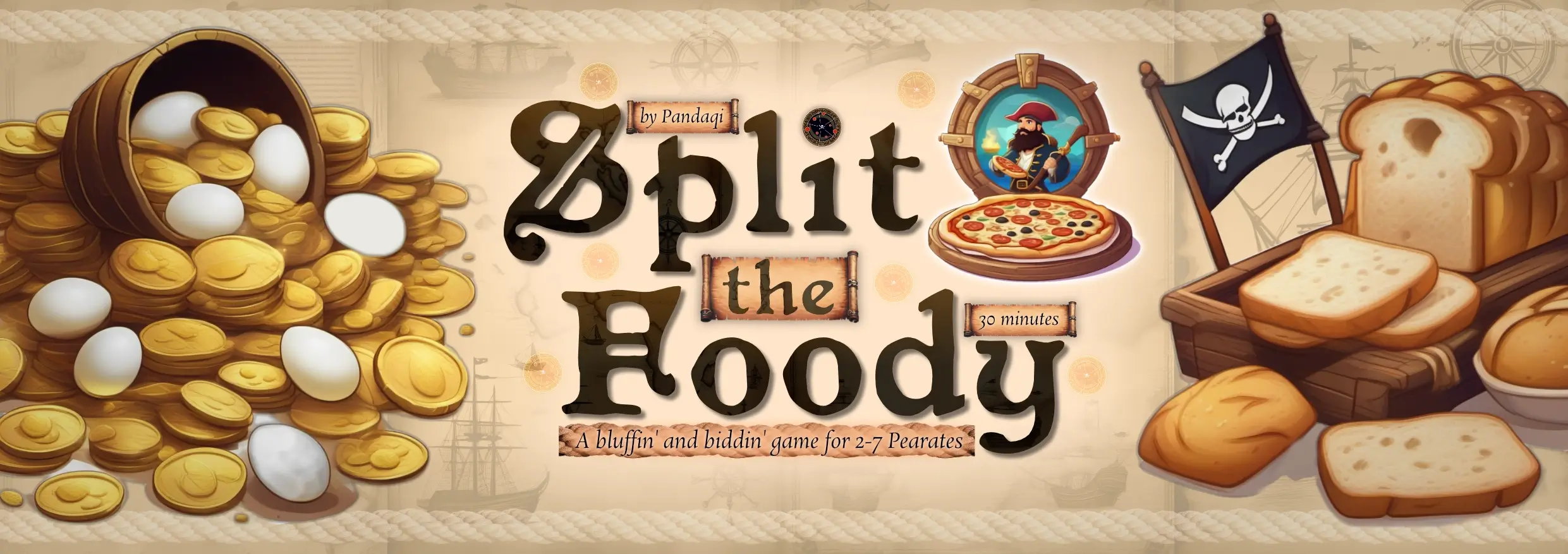All players receive 5 cards. The remaining cards become a (shuffled) facedown deck: the draw pile.
For a shorter game, simply remove any number of cards from the deck. (Anybody may look at the cards removed.)
Biggest food thief starts.
The game ends after the round when the draw pile runs out. All players count their score: highest score wins.
Each round …
- The start player locates a new treasure (Draw).
- Clockwise, players take turns reacting to it: Pass, Bid, or Play.
- This continues until all players have Passed.
- The treasure is split (Split Treasure).
- Start player advances clockwise.

Each individual step should be simple and fast. They’re all explained below.
On being a Pearate: it’s absolutely allowed to lie, bluff, etcetera. Bluff about what’s inside your treasure. Promise something, then break that promise. As long as you follow the rules explicitly stated in this rulebook.
This is done by the start player.
- Take the bigger number: your hand size or 2.
- Draw that many cards from the deck: this is the secret treasure for this round.
- Look at the treasure and arrange the cards any way you wish.
- Then place it facedown in the center of the table.
Passing simply means doing nothing for the rest of this round.
You bid by placing one or more cards facedown before you. Each card is worth 1. You DON’T need to bid more than the previous player!
Or you can play a card from your hand with an action. Execute the action immediately, then add this card to the treasure.
Whenever an action allows you to add/remove cards, you may
- Do so from the top OR the bottom of the treasure.
- Take them from your hand or from the deck.
Total bid is larger than the treasure size (a “Mutiny”)? The player with the highest bid receives the treasure. (If tied, the start player chooses.) The start player receives the highest bid; everyone else receives their own bid.
Otherwise? Treasure is divided. In turn order, each player takes as many cards as they put in, either all from the top or all from the bottom. The start player receives all the bids. Leftover treasure is discarded.
Finally, everyone makes a choice about all cards they received during this round: either take them all into your hand or score them all.
The hand limit is 8 cards. If you can’t fit all new cards into your hand, you must score them.

“Scoring” a card simply means placing it faceup in front of you. You can’t use these cards anymore.
When determining the winner at the end of the game …
Only count types of which you have the most (out of all players). Ties for majority are allowed.
Highest score wins. If tied, the player with the most hand cards wins.

Once you’ve played the base game a few times, maybe you’re ready for some expansions or variants!
Want a friendlier game? Use the following rules.
- If nobody bids on a treasure, the start player receives it.
- Every trio of cards with a value below 4 (in your score pile), is worth +5 points.
- In the final round, you automatically score all cards received.
- Optional: remove some or all of the negative numbers.
Want a more strict rule for resolving ties? Use the following rule. (This variant was mostly removed to simplify your first few games.)
In case of a tie ( = multiple players bid the most), the cards are revealed and “scored”. Highest score wins. If still equal, divide the treasure between the tied players, as fairly as possible, throwing away leftover cards.
Want a longer game? When the draw pile is empty, shuffle the discarded cards and make it the new draw pile. You can do this once, or twice, or however long you want the game to last.
This one adds more cards with special actions.
You’re also allowed to strike deals using cards received in a round. For example, you might promise somebody part of your treasure if they stop bidding now. Whether somebody follows up on their promises …
Once a card is definitively scored or in your hand, however, you can’t strike any more deals with it.
This one introduces cards that score in a special way.
Their action isn’t relevant while playing the game and cannot be used with the “Play” action. Instead, their action is permanent and triggers when it says so. (Usually it’s a rule that determines their worth when scoring at the end of the game.)
These cards have a golden (“score”) coin underneath the numbers to remind you of this fact.
